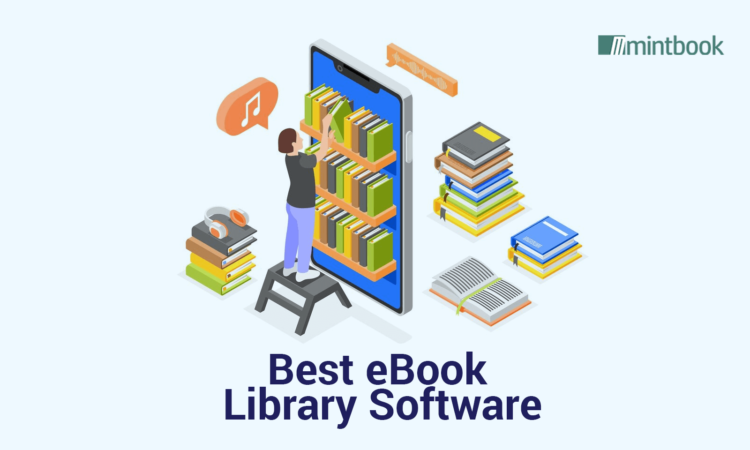
In Canada, many schools crack down on cell phone usage to keep students safe. However, the statistics compiled by Statista suggest that over 87% of teenagers aged between 12 and 17 years use smartphones regularly in Canada. The access to mobile devices makes a large percentage of students prefer eBooks to printed or physical books.
A student can access eBooks anytime and anywhere using a desktop, laptop, smartphone, or tablet. Also, eBooks, unlike conventional books, provide a wholesome learning experience by combining text, images, audio, video, and multimedia. Hence, schools, colleges, and universities can no longer boost learner engagement and learning experiences without replacing printed books with eBooks.
In addition to driving online and distance learning, the eBook library software helps modernize the classroom-based learning model. An educational institution can meet the needs and expectations of Gen Z learners by choosing from many digital libraries. However, decision-makers must select and implement the best eBook library software by comparing the edtech solutions using a slew of criteria.
10 Criteria for Choosing and Implementing the Best eBook Library Software
1. Accessibility
eBook library software helps organizations foster self-paced learning. Students will use the software to access eLearning content in their own way and schedule. Decision-makers should remember that most students these days consume digital content using smartphones or tablets. Hence, they must ensure that each student can access the digital library using his preferred device. In addition, they must prioritize software that delivers optimal mobile user experiences.
- Content Formats
EBooks are currently one of the most popular eLearning content formats. However, many students prefer audio or video content to eBooks while learning a topic. Hence, decision-makers must prioritize software that supports different content formats, including eBooks. Leading digital library platforms enable students to access eLearning content in various formats – eBook, audio, video, simulations, journals, and quizzes.
- Content Curation
The best eBook library solutions help students understand a topic deeply by sharing content curated from external sources. They usually share curated content created by subject matter experts. New-age digital library software further curates relevant and engaging content using artificial intelligence (AI) technologies. Hence, decision-makers should prioritize eBook library software that provides off-the-shelf content and shares curated content.
- Language Support
Leading educational institutions these days support vernacular education. They create opportunities for students to acquire knowledge in local or regional languages. Multilingual content access is a key requisite for making vernacular successful. It becomes easier for educational organizations to support vernacular education when the digital library software delivers content in regional languages. Decision-makers need to ensure that their choice of eBook library software is developed with multilingual support.
- Learner Engagement
While selecting the best eBook library software, decision-makers must remember that the online course completion rate is abysmally low. About 85% of students abandon online courses and certification programs due to various reasons. Hence, they need online library software that boosts online course completion rates by keeping students engaged. They should prioritize software that keeps students engaged using popular gamification techniques badges, coins, and scorecards.
- Content Mapping
Students enrolling in various courses and certification programs will access the same digital library software. Administrators must enable each student to access relevant content according to his choice of course. It becomes easier for them to link content to specific courses when the eBook library solution supports content mapping. The feature will help them create content plans for individual courses or certification programs without putting in extra time and effort.
- Option to Customize and Sale
The eBook library software is designed as a repository of multi-format eLearning content. Hence, administrators must customize the content repository according to their precise needs. Likewise, they must scale the online repository to accommodate more students and content. Administrators can customize and scale cloud-based digital library platforms on demand.
- Dashboards
Administrators can boost the online learning experience of students only by understanding their content needs and preferences. Hence, they must monitor how many students access the digital library and what content format they prefer. The dashboard provided by the digital library software helps administrators access real-time information about library content and students. Also, an administrator can use the dashboard to facilitate decision-making by generating and scheduling custom reports.
- Integration Capability
Every organization needs multiple eLearning tools to boost online learning and distance learning. It further needs to build a unified learning platform by integrating the standalone eLearning solutions. Hence, decision-makers must check if the digital library software can be integrated with existing eLearning solutions like learning management systems and online classroom software. The integration capability is essential for every educational institution to build unified learning platforms.
- Awards and Recognitions
While comparing eBook libraries, decision-makers must consider the provider’s reputation and goodwill. They must evaluate the software by reading the reviews posted by existing users. In addition, they should prioritize digital library software that stands out from the crowd by winning prestigious eLearning awards and certifications and meeting international quality standards.
Conclusion
The best eBook library software helps schools, colleges, and universities meet the expectations of new-generation students. Educational institutions must switch from conventional libraries to digital libraries to enable students to understand a topic or concept in various ways – reading text, seeing images, watching videos, and listening to audio.
Also, students can eLearning content anytime and anywhere using computers or mobile devices. However, decision-makers can leverage additional benefits by opting for cloud-based digital library platforms. In addition to being easier to implement and configure, cloud-based eBook library solutions can be customized and scaled on demand.
Also, cloud-based solutions can be integrated with existing eLearning tools effortlessly using application programming interfaces (APIs). An educational organization can use APIs to build a unified learning platform by combining essential eLearning tools. However, decision-makers should consider digital library software available as a core component of a unified learning platform.




